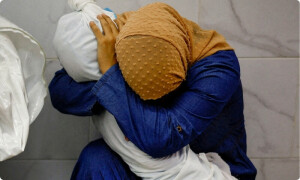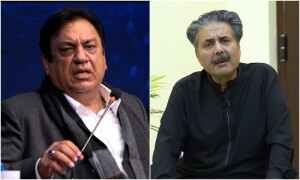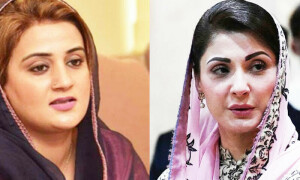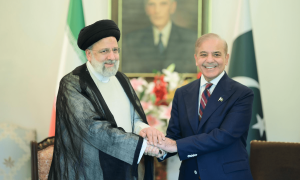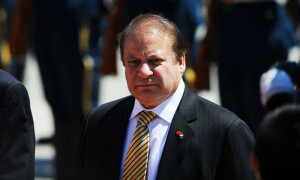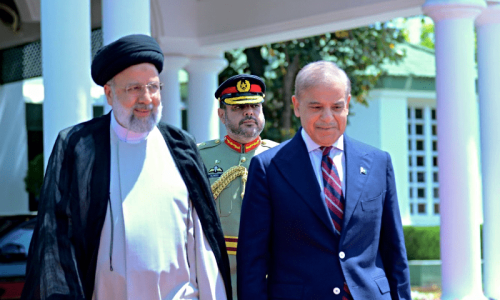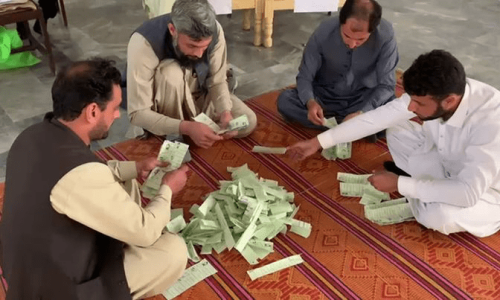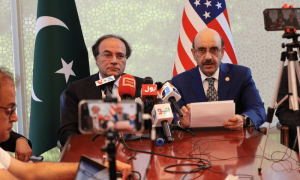ON Wednesday, the government tear-gassed inflation. The results have been fairly mediocre. At the end of the day, that witnessed the Red Zone turning into a battlefield reminiscent of PTI’s assault on the Prime Minister’s House six years ago, the problem continued to persist stubbornly. Unforeseen trouble can be the worst kind.
And yet, this should not have been unforeseen at all. Government employees had been demanding a raise in wages for months now. They had held numerous demonstrations over the course of time and none had turned violent. This time when they gave a call for their colleagues to gather in Islamabad, the government decided to toughen up.
The result is a PR disaster for PTI. And the worst part is that it is not over. There are hundreds of government employees camped in and near the Red Zone and refusing to disperse till their demands are met. The central demand is a wage increment not less than 40 per cent for all government employees in all grades. Their argument is that inflation has wreaked havoc with their monthly household budgets and they are unable to meet basic expenses. The government has offered to meet their demands half way after today’s showdown but the protesters are not interested in the offer so far. There could be more trouble.
Inside power corridors there are worried faces. They recognise the complexity of the situation. It is not just the violent confrontation with a large number of angry citizens in the heart of the federal capital, it is the issue underlying this confrontation. Inflation is PTI government’s greatest vulnerability, its Achilles’ heel, so to speak. It was this very issue that the opposition’s PDM movement was banking on in its campaign against the government because it is this issue that resonates the most across the country. Wednesday’s violence inside the Red Zone was the most high profile manifestation of the misery that inflation is wreaking on citizens, and it has the potential to strike a popular chord that may scale up if not settled soon. Experienced people in the government therefore realise the danger that Wednesday’s confrontation poses if it is not handled deftly and swiftly.
PDM is sensing an opportunity. Violence has its own dynamics, and if it happens in the most sensitive area of the capital under the full glare of the media, then the dynamics are turbo-charged. When such violence is perpetrated by the government, the unpredictability of consequences becomes the biggest worry for those in power. Thursday is crucial. If the government can strike a deal and succeed in dispersing the protesters, a potentially dangerous situation could be averted. But if the situation persists for longer, and there is more violence, the situation could quickly turn political.
It could not have come at a worse time. There are certain key people inside the PTI government who are recognised and acknowledged as hard-nosed politicians who can sense and smell political trouble before it erupts. Interior Minister Sheikh Rashid and Defence Minister Pervaiz Khattak are two such people. They may not be part of the inner-most circle of Prime Minister Imran Khan — for various reasons — but when it comes to assessing the wind, these two are who most party leaders turn to.
Inside the Red Zone, there is a fairly clear-eyed assessment of where the pressure points for the PTI government exist today: (1) Relationship with the establishment, (2) Foreign funding case, (3) Possible upset in Senate elections, (4) Public protest over inflation, and (5) Local bodies elections in Punjab. Each one of these pressure points, if it explodes, can have severe consequences for the PTI government. Important to note that PDM is not listed among these five points. However, if one or more of these flare up, PDM’s long march scheduled for March 26 could get infused with new lethality.
Insiders in the government admit that these five dangers are lurking perilously close to them. They are also giving rise to whispers about March being a crucial month for all political stakeholders. March is usually fertile for political whispers and they swirl around every year for one reason or another. But this March is seeing a convergence of key events within the larger overhang of these five pressure points.
The relationship with the establishment is nowhere near rupturing. However, officials admit that there is concern about the overall governance by the government. Many senior people in the establishment are continuing to remain deeply involved in “propping up” the government in terms of specific areas where poor governance is visibly apparent. Micromanagement is not unheard of. The relationship is sturdy, almost paternalistic, but many in government admit it cannot be taken for granted. It has to be managed.
The foreign funding case is crawling towards a conclusion. At best, it could weaken PTI — at worst, it could cripple it. If federal minister Faisal Vawda gets hit on the dual nationality charge, it would indicate which way the wind is blowing. The case may not have a verdict any time soon but at each successive hearing, PTI bleeds a little.
The Senate elections have become a double-edged sword for the government. There is genuine concern within government quarters that a secret ballot could produce a surprise at their expense. The 2018 video showing parliamentarians from Khyber Pakhtunkhwa taking money for their Senate vote can also boomerang on to PTI if the accusations against senior party leaders — including the one that it was shot in an important official building — find traction, significant filth could be generated, blended, churned and hurled towards the Red Zone.
On the local bodies elections, the Supreme Court may force the government’s hands. There is some behind-the-scenes maneuvering still under way in Islamabad and Lahore to grapple with the uncertain projections of the LB polls. In Punjab, PTI faces a daunting task of campaigning when inflation and prices of utility bills are hurting the voters deeply. If PTI loses in Punjab, it could have a devastating impact on its standing and credibility.
This is why the fourth pressure point — protest linked to inflation inside the Red Zone — can light a fuse just when the government wants none lit. It is a test of nerves for a party that only a few years ago was indulging in exactly the same activity in the same spot that it is today trying to suppress.
On Wednesday, karma too was trending in Islamabad.
Published in Dawn, February 11th, 2021






